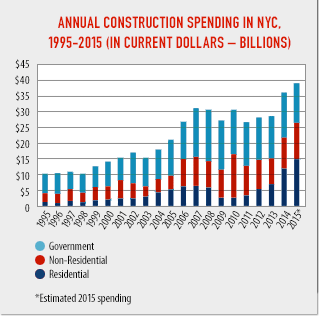
2015 construction activity yielded an estimated $61 billion in total economic impact to new york city
Ripple Effects Felt throughout the Five Boroughs
The benefits of New York City’s current building boom are reverberating throughout the local economy, generating an estimated $61 billion in total economic output in 2015 alone, according to a New York Building Congress analysis of multiple data sources. This is a 7 percent increase from 2014, when the overall economic impact totaled $57 billion.
The Building Congress estimates that a total of $39 billion was spent on construction projects throughout the five boroughs in 2015, and that this direct construction spending generated another $22 billion in ancillary business activity and increased consumer spending. This represents a multiplier effect of $1.56, as each dollar spent on construction yielded an additional $.56 in overall economic activity.
Of the $22 billion, the Building Congress attributes $11.6 billion to the indirect impact of construction, which includes all employment and income generated by businesses that service the industry, such as architectural, engineering, legal, and other firms. The remaining $10.4 billion is attributable to the induced impact of construction, which is the result of workers and suppliers spending their wages on local consumer purchases, such a clothing, food, and transportation.
Construction also played a role in the creation of more than 300,000 local jobs in 2015. In addition to the 181,000 men and women employed in the design, engineering, and construction industry, last year’s activity produced another 132,500 jobs throughout New York City’s economy. Approximately 70,000 jobs were created in fields that service the construction industry, such as lawyers, accountants, and suppliers. Still another 63,000 jobs were induced by the increased household earnings that resulted from direct construction and the related expansion of economic activity. The annual average salary for all direct, indirect, and induced employment was $84,000.
“In addition to sowing the seeds for long-term economic growth, a healthy construction sector is a tried-and-true source of immediate economic stimulus for New York City,” said New York Building Congress President Richard T. Anderson. “Given that three-quarters of the construction labor force lives in the five boroughs, the ripple effects of all this spending and employment is enormous.”
Residential
Of the three main sectors, residential construction yielded the greatest economic impact in 2015. In addition to an estimated $14.9 billion in direct spending, residential construction yielded $6.3 billion in indirect output and $4.1 billion in induced economic benefits. The combined $25.3 billion represents an estimated 23 percent increase from 2014, when the total economic output was $20.5 billion.
Non-Residential
Non-residential construction, which includes office space, institutional development, sports/entertainment venues, and hotels, led to a total 2015 economic output of $16.7 billion, including $11.6 billion from direct spending, $2.2 billion of indirect output, and $3.0 billion from induced effects. This estimated level of economic output represents a 16 percent increase from the 2014 figure of $14.4 billion.
Government
Government construction spending, which includes investments in mass transit, roads, bridges, and other essential infrastructure, stimulated $18.9 billion in 2015 output – a decline of 14 percent from the 2014 total of $22.0 billion. The 2015 impact is based on an estimated $12.6 billion in direct spending while the indirect and induced effects reached $3.1 billion and $3.2 billion, respectively.
Dodge data used for this analysis can be purchased at construction.com/dodge/.
Charts and Diagrams

Sources: Dodge Data & Analytics, Public Agency Capital Budgets/Plans, & Urbanomics

Sources: Implan Pro Model for NYC and Urbanomics



